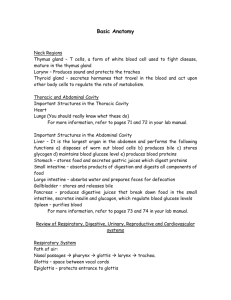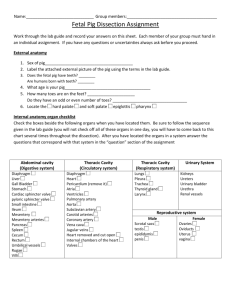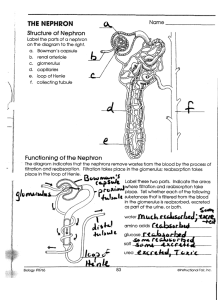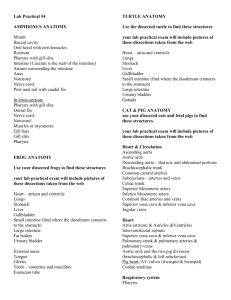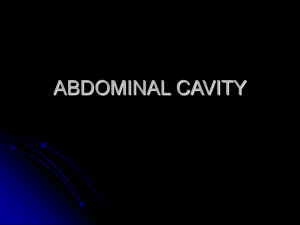Anatomy Semester Exam Study Guide
advertisement
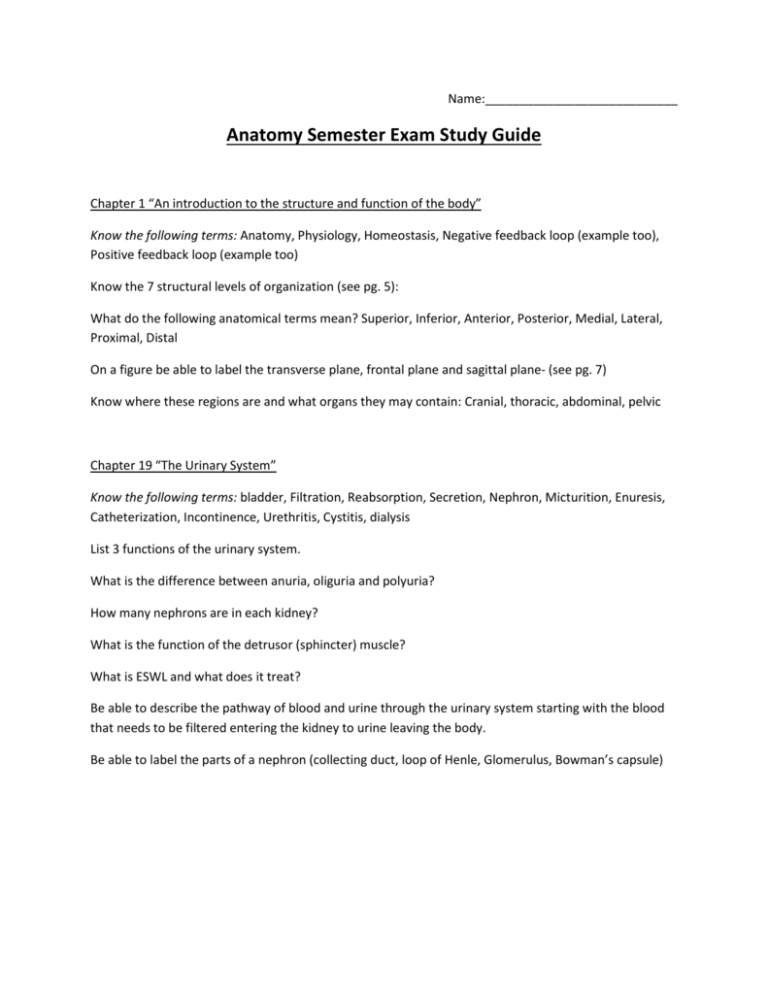
Name:____________________________ Anatomy Semester Exam Study Guide Chapter 1 “An introduction to the structure and function of the body” Know the following terms: Anatomy, Physiology, Homeostasis, Negative feedback loop (example too), Positive feedback loop (example too) Know the 7 structural levels of organization (see pg. 5): What do the following anatomical terms mean? Superior, Inferior, Anterior, Posterior, Medial, Lateral, Proximal, Distal On a figure be able to label the transverse plane, frontal plane and sagittal plane- (see pg. 7) Know where these regions are and what organs they may contain: Cranial, thoracic, abdominal, pelvic Chapter 19 “The Urinary System” Know the following terms: bladder, Filtration, Reabsorption, Secretion, Nephron, Micturition, Enuresis, Catheterization, Incontinence, Urethritis, Cystitis, dialysis List 3 functions of the urinary system. What is the difference between anuria, oliguria and polyuria? How many nephrons are in each kidney? What is the function of the detrusor (sphincter) muscle? What is ESWL and what does it treat? Be able to describe the pathway of blood and urine through the urinary system starting with the blood that needs to be filtered entering the kidney to urine leaving the body. Be able to label the parts of a nephron (collecting duct, loop of Henle, Glomerulus, Bowman’s capsule) Ch. 17 “The Digestive System” Know the following terms: Digestion, Mastication, Pharynx, Chyme, Bolus, Rugae, Peristalsis, Ulcer, Greater omentum, Uvula, jaundice Know the four layers of the small intestine in order from outside to the inside. What are three major functions of the stomach? Compare/contrast mechanical and chemical digestion What are the three sections of the small intestine? What is the function of microvilli? Which organ stores bile? Which organ secretes insulin? What is the main function of the large intestine? Ch. 13 & 14 “Heart/Circulatory System” Know the following terms: Atherosclerosis, Myocardial infarction, Angina pectoris, Embolism, Hypertension, Heart murmur, Coronary bypass, Cardiac cycle, Stroke volume, Electrocardiogram, dysrhythmia What is the difference between the pericardium, myocardium and endocardium? Compare/contrast systole and diastole heart actions. What part of the heart’s electrical system is known as the pacemaker? What is the difference between bradycardia and tachycardia? Describe the flow of blood through the heart and body starting with the vena cava: Be able to label the following on the diagram of the heart (left & right atrium, left and right ventricle, tricuspid valve, mitral (bicuspid) valve, aorta, superior and inferior vena cava) Ch. 12 “Blood” Know the following terms: Plasma, Acidosis, Antigen, Antibody, Agglutinate, Erythrocytes, Leukocytes, Thrombocytes, Hemoglobin, Hemophilia, Hematopoesis What is the difference between polycythemia and anemia? Describe the cause and symptoms of Sickle Cell anemia: What blood type is the universal donor? Universal recipient? What would happen in the following transfusions? Type O is donated to Type AAB is donated to AWhat is the function of red blood cells? Know the three basic steps of blood clotting (pg. 360-361) Ch. 15 “The Immune System” Be able to describe the following components of the immune system: Nonspecific responses- Fever and inflammation Specific responses- Cellular immunity (T-cells) and Humoral immunity (B-cells) Compare and contrast a virus and bacteria. Give examples of each. Know the ways that someone can contract HIV Know what does AIDS & HIV stand for? What is the difference between HIV and AIDS? Sexually Transmitted Diseases Unit Know the complications that can result from STD’s. Know the characteristics of chlamydia, HPV, syphilis, trichomoniasis, hepatitis B, genital herpes Know how the various STDs are treated (antibiotic, vaccine, no treatment) Skeletal System Know the following terms: ossification, osteoblasts, osteocytes, osteoclasts, suture, fontanel Know the two main divisions of the skeletal system and their components (Axial vs. appendicular) Know the four types of joints and an example of each. Be able to label the major bones of the human skeleton. Study your flashcards and worksheet. Know the location of the following skull bones: frontal, parietal, temporal, mandible, maxilla, occipital Be able to identify the three major regions of the spine. Know the bone disorders described in the powerpoint.


